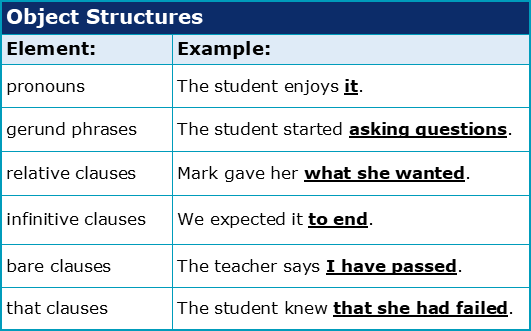Do essays use direct, indirect and oblique objects?

This is the third and final chapter about Subjects and Objects. To complete this reader, read each chapter carefully and then unlock and complete our materials to check your understanding.
– Review the concept of subject and object phrase functions
– Explore the various methods for building objects beside noun phrases (such as gerunds and clauses)
– Discuss verb transitivity the three types of object (direct, indirect and oblique)
Before you begin reading...
-
video and audio texts
-
knowledge checks and quizzes
-
skills practices, tasks and assignments
Chapter 3

In this third and final chapter about subjects and objects, we next focus on the three types of object which are used in English: direct, indirect and oblique objects. We review the differences between subjects and objects and briefly explore the concept of verb transitivity and how it determines the number of objects required. Then, we look at those three object types in detail before turning finally to their use in essays and other academic settings.
How are objects different from subjects?
Subject and object phrase functions might share a good number of similarities but they are ultimately not the same.
For example:
- subjects are usually placed before the verb phrase while objects are placed after it
- subjects are usually the doer of the action of the verb while objects are the receiver
- both subjects and objects are most commonly made from simple or complex noun phrases
Subjects and objects are nevertheless so similar to each other that they can often be swapped with no change to the grammar – only a change in meaning. Clearly, this alternation is not always possible however due to meaning and logic errors:


Because they are so similar, one useful way of telling a subject and an object apart (aside from inspecting their function) is to look for any pronouns which have been used to form them. The subject pronoun ‘I’, for example, is written as ‘me’ when it’s in the object position, such as how ‘she’ becomes ‘her’ when placed after the verb:

Are objects also mostly made from noun phrases?
Like subjects, objects are also most commonly made from simple noun phrases (such as determiner–noun combinations) and complex noun phrases (by combining prepositional phrases and relative clauses). Students should however be careful to recognise those objects which have been composed from other types of phrases and clauses, as has been exemplified in the below table:

How does verb transitivity affect the number of objects?
The transitivity of a verb (its valency) is a very important verb function when trying to determine how many objects to include within a sentence. As the following table demonstrates, verbs can be divided into four types depending on how many objects they require. There are intransitive verbs which have no objects, monotransitive verbs which have one object, ditransitive verbs which have two and tritransitive verbs which have three:


How many types of object are possible?
What the previous table additionally shows us is that there are three possible types of object phrase function. These are:
- direct objects (usually the receiver of the action or intention of the verb)
- indirect objects (usually the being that benefits from the action of the verb)
- oblique objects (usually the object which follows a preposition such as ‘to’ or ‘for’)
- direct object ONLY (failed the exam)
- indirect object THEN direct object (taught the students English)
- direct object THEN oblique object (taught English to the students)
- indirect object THEN direct object THEN oblique object (sold John a hat for $10)
- direct object THEN oblique object THEN oblique object (sold a hat to John for $10)
Are direct, indirect and oblique objects academic?
While objects are a somewhat optional part of a grammatical sentence (at least when using an intransitive verb), it would be impossible to write an academic essay in English without them. Monotransitive verbs are in fact very common in academic writing, with 142/150 high frequency academic verbs falling into this category. For each of the 142 verbs listed next, for example, a student would need to include a direct object after the verb phrase to make their sentences grammatical.
accept, achieve, adapt, advance, affect, allocate, allow, alter, analyse, arise, assert, assess, associate, assist, assume, attempt, avoid, base, benefit, cause, choose, cite, claim, clarify, classify, combine, compare, concentrate, conclude, conduct, connect, consider, consist, constitute, construct, contrast, correspond, decline, define, demonstrate, depend, describe, design, determine, develop, differ, discuss, display, distinguish, effect, eliminate, emerge, enable, encounter, encourage, enhance, ensure, evaluate, examine, exceed, exemplify, expand, explain, express, facilitate, favour, form, formulate, generate, highlight, identify, illustrate, imply, improve, include, increase, indicate, influence, interpret, introduce, investigate, involve, isolate, lead, limit, locate, maintain, measure, neglect, note, obtain, outline, overcome, perceive, possess, predict, present, prevent, produce, prove, provide, publish, pursue, quote, receive, reduce, reflect, regard, reinforce, relate, remove, replace, report, represent, reproduce, resolve, respond, restrict, retain, reveal, select, separate, show, solve, specify, state, strengthen, stress, study, submit, suggest, summarise, support, tend, transform, treat, undermine, undertake, vary
“The board allocated $3,000 to the study.”
“The results benefited group A more than group B.”
“The scientists developed the vaccine over the course of three years.”
“I identified the problem with the methodology and rescheduled the test.”
“The experiment involved 2,500 participants from fifty-six countries around the world.”
Only 7/150 of the most common academic verbs are ditransitive or tritransitive, however. These seven verbs (each requiring two or three objects) are:
allocate, allow, cause, design, present, provide, show
“The teacher allocated the students their homework.”
“The scientist allowed them the results.”
“She designed them the prototype they asked for.”
“The results provided him the answers he needed.”
“The results showed her the likely answer to her thesis.”

What this shows is that while objects are very common in academic language (EAP) indirect and oblique objects will be far less frequent than direct objects.
Excellent work on completing this short reader on subjects and objects. Consider next taking our short readers about predicates or adverbials and complements.
Downloadables
Once you’ve completed all three chapters in this short reader about Subjects and Objects, you might then wish to download our Chapter Worksheets to check your progress or print for your students. These professional PDF worksheets can be easily accessed for only a few Academic Marks.
Chapter 1 explores the topic: What are subject and object phrase functions? Our Chapter 1 Worksheet (containing guidance, activities and answer keys) can be accessed here at the click of a button.
Chapter 2 explores the topic: How are subject NPs useful for academic English? Our Chapter 2 Worksheet (containing guidance, activities and answer keys) can be accessed here at the click of a button.
Chapter 3 explores the topic: Do essays use direct, indirect and oblique objects? Our Chapter 3 Worksheet (containing guidance, activities and answer keys) can be accessed here at the click of a button.
To save yourself 2 Marks, click on the button below to gain unlimited access to all of our Subjects and Objects Chapter Worksheets. This All-in-1 Pack includes every chapter, activity and answer key related to this topic in one handy and professional PDF.
Collect Academic Marks
-
100 Marks for joining
-
25 Marks for daily e-learning
-
100-200 for feedback/testimonials
-
100-500 for referring your colleages/friends